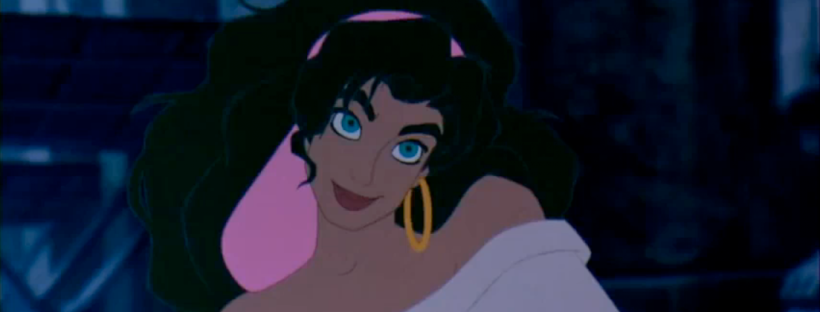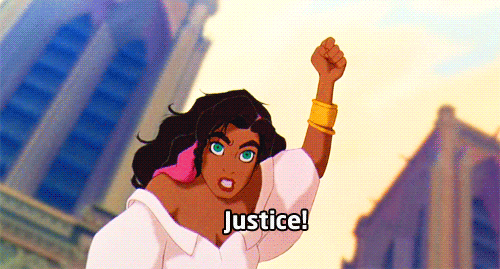This series analyses Disney movies and shows from a feminist or other critical perspectives. It is not condemning Disney; it is analysing a beloved piece of childhood from an adult point of view
The Hunchback of Notre Dame was released in 1998, and it was never truly well-received. The conception was too conflicting. For the most part, it is a beautifully animated and compelling story, told with a sincerity and that famous Disney charm. It was dark, but so was the original source. On the opposite side of the conflict, there was unfunny comic relief and annoying side-characters. This post isn’t about them though. It’s about Esmeralda.
Esmeralda is the Romani street dancer from The Hunchback of Notre Dame, and possibly the only social justice warrior of the Disney renaissance. Princesses and heroines had stood up for honesty and against their foes before, but Esmeralda was speaking for more than that. She spoke for her people, and she spoke for justice. She is a woman of colour who takes no blows for who she is. She’s feisty, she’s quick-witted, but she is also very grounded and passionate.
Her only song is not about wanting more in life a la Belle (Reprise) or Part of Your World. She sings God Help the Outcasts, walking the other way from the selfish congregation as they wish for material possessions and glory. Her prayer is simple:
God help the outcasts, hungry from birth. Show them the mercy they don’t find on earth. God help my people, we look to You still. God help the outcasts, or nobody will.
She wants only for her people not to live in fear. It is a beautiful hymn with a deep message. She is called gypsy and has money she’s earned taken from her. She deals with racism and the corrupt law system that would sooner see her exterminated than protected. It is an allegory which works today, with stories like Sandra Bland and Mike Brown making international headlines.
A big criticism that is usually levied against Esmeralda is that she ends up with Phoebus. Phoebus is the captain of the guard, and he is the conventionally attractive pretty boy in the trio of interested men. The other two are the villain—the old and lecherous judge, Claude Frollo—and the hero of the movie—the disabled and unattractive Quasimodo. To Esmeralda’s credit though, Phoebus is the only option who treats her as a person. Frollo is an old pervert who wants to possess and burn Esmeralda, casting her as a witch in fantasies to explain his unholy thoughts. Quasimodo has the exact opposite problem; he casts her as an angel, and sees her as a perfect being. Being a sex object or on a pedestal are both dehumanising, albeit with different connotations. Esmeralda ends up with the man who shares her belief in justice, and who takes the time to get to know her as a person.
Esmeralda is sexualised in her design. She dances around a pole for money, which is pretty risqué for a Disney movie. Even her smoke silhouette is sexy. The infamous villain’s song Hellfire shows a smoke version of Esmeralda dancing in the flames of the fireplace in a fantasy sequence, beckoning and attempting to embrace Frollo. Animators had to go through frame-by-frame and made sure there was no errant nipple to offend the audience. In the commentary, director Kirk Wise said she was designed to look like she’d “been around”. It is unfortunate phrasing, meant to indicate she is older then the traditional heroine, but it adds to this sexualised image of a great character.
Disney is not the first adaptation to sexualise Esmeralda. Hugo’s Esmeralda was a beautiful 16 year-old girl who was desperately in love with Phoebus; she was not a sex siren. Yet many adaptations have written her as possessing sexual charms to some degree. Disney at least places the perversion on the characters to ogle her.
Frollo’s attitude towards her is especially relevant to a feminist interpretation. He is the essence of victim blaming. He blames her for his ‘unholy thoughts’, and calls her witch. He would rather believe she was manipulating him than admit that he is attracted to her. And there is no shame in that, she’s gorgeous.
That she is the only speaking female role outside the comic relief gargoyle is honestly a shame. Esmeralda has all the makings of Disney feminist fave. The Hunchback of Notre Dame is a classic that needs more love than it’s received over the years. Its soundtrack is incredible, the hand-drawn animation still holds up well, and Esmeralda is one of the greatest female characters Disney has ever written.


![When a creep gets in your personal space [Caption reads: Do not want]](https://fridaysfeminist.wordpress.com/wp-content/uploads/2015/08/do-not-want.gif?w=620)